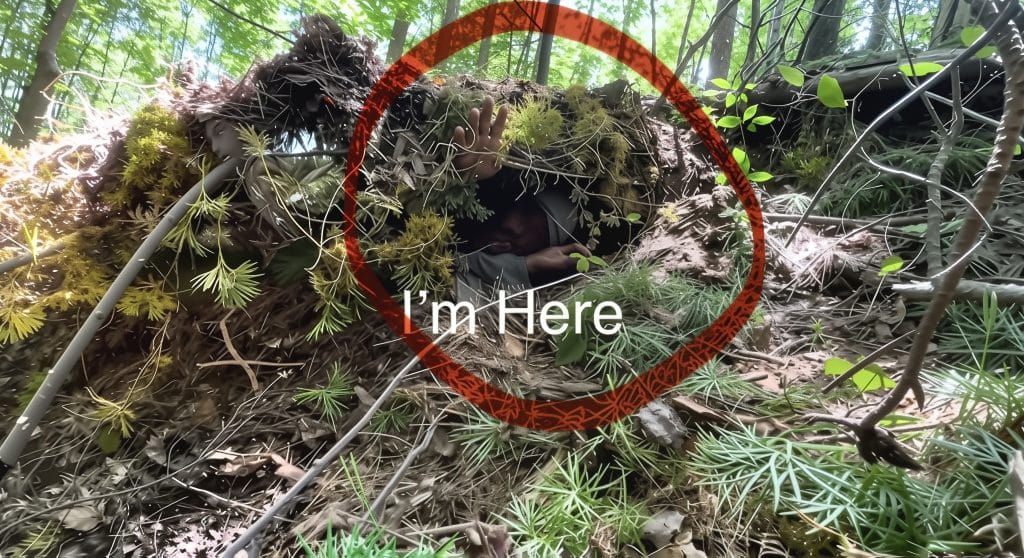
Most emergencies happen near urban centers rather than deep in the wilderness. According to Federal Emergency Management Agency, displaced populations during major disasters typically remain within fifty miles of cities. This means your survival plan should work where people are, not just in remote forests.
Recent events have proven this over and over.
Hurricane Katrina displaced millions of people who stayed close to populated areas. California wildfires forced evacuation along the urban edge, not into deep wilderness. Hurricane Helene showed that stealth and proximity can be just as critical as isolation during a crisis.
An urban survival shelter gives you the ability to disappear in plain sight, maintain cover near resources, and control your exposure in unstable environments.
The best shelter sites are not the most scenic or comfortable. They are the ones nobody notices. Thinking like someone who doesn’t want to be found changes everything about how you evaluate the ground.
☐ Avoid paths of least resistance such as roads, trails, and clearings
☐ Use natural terrain features like hillsides, washes, and draws for concealment
☐ Control sight lines by walking the perimeter before digging
In my own test, I built a shelter just twenty yards from a road in a natural draw. It vanished from view because of the terrain alone.
For this build, I used a simple entrenching shovel. The point isn’t to have the perfect kit. It’s to develop skill with whatever you have in your hands.
☐ Keep gear minimal to improve adaptability
Start by measuring your shelter using your own body as the template.
☐ Mark the footprint with your full body length
☐ Cut into the hillside slowly in layers to avoid collapses
☐ Level a sleeping platform roughly six feet long and two to three feet wide
☐ Scatter excavated dirt far away and cover with natural debris to eliminate signs of activity
These steps give you a hidden, stable base to work from.
A good shelter is not just about concealment. It must keep you warm, dry, and off the cold ground. I used white pine boughs for cushioning and insulation. They are soft, springy, and quiet to harvest.
☐ Harvest pine boughs or local equivalent
☐ Process quietly at the shelter to reduce noise signature
☐ Insert the cut ends into the ground to create a springy platform
A comfortable bed protects your body from cold and fatigue, increasing your chances of staying alert.
The shelter framework should blend with nature, not fight it. I used irregular deadfall branches to shape the roof. Straight lines are a giveaway to any trained eye.
Cover can come from almost anything: a Mylar emergency blanket hidden under vegetation, scavenged cardboard, plastic sheeting, fabric, or discarded construction material.
☐ Keep the structure low and irregular
☐ Eliminate shine completely with local vegetation
☐ Anchor cover without puncturing reflective material
Camouflage is about how the human eye reads shapes, light, and movement. Even the best gear fails if the silhouette gives you away.
☐ Keep a low profile
☐ Avoid geometric shapes
☐ Choose secluded locations
☐ Use local vegetation and debris
☐ Eliminate every reflective surface
Standing still in shadows can be more effective than camouflage clothing. Movement is what catches attention.
Fire can expose you faster than anything else, but it can also save your life. The Dakota fire hole is your best option in urban stealth scenarios.
Dig a main chamber and a smaller air feed tunnel about eighteen inches away
Tunnel between them for airflow
Burn dry twigs for minimal smoke
When done, bury completely
☐ Keep fires small and quick
☐ Avoid unnecessary smoke or light at night
This simple method produces efficient heat and nearly zero visible flame.
Your shelter is only as strong as your ability to access clean water and calories. Urban and suburban areas have surprising resources if you know where to look.
☐ Creeks and retention ponds with purification
☐ Hot water heaters in abandoned buildings
☐ Rainwater collection from hard surfaces
☐ Urban foraging in lots and parks
☐ Dumpster recovery behind restaurants
☐ Fishing urban ponds
☐ Trapping small game
These tactics keep you mobile and alive without drawing attention.
All training should happen legally and responsibly. I built my shelter on my own property. Trespassing can lead to real problems even during emergencies.
☐ Practice legally and get permission where required
☐ Use dead wood instead of cutting live trees
☐ Scatter disturbed soil and naturalize your site after use
Leaving no trace keeps the land intact and protects future training sites.
Summer shelters should maximize airflow and shade. Working in heat requires pacing and hydration.
☐ Keep the shelter open and ventilated
Winter shelters should trap warmth and limit exposure.
☐ Close the structure with debris
☐ Dig deeper for ground insulation
☐ Maintain minimal but effective ventilation
Earth shelters regulate temperature naturally, but small adjustments for each season make a big difference.
These skills need repetition, not theory.
☐ Week 1 Site selection walks
☐ Week 2 Daytime builds
☐ Week 3 Minimal gear challenge
☐ Week 4 Timed shelter build
☐ Week 5 Overnight stay test
Skill becomes instinct when practiced under different conditions.
☐ Building too close to obvious paths
☐ Leaving piles of fresh dirt
☐ Ignoring water flow and drainage
☐ Shiny or geometric shapes in the build
☐ Poor fire discipline
Every error makes you easier to find.
Is it legal to build a shelter like this
Yes on private land or with permission.
How long can you stay in one
Days to weeks depending on resources and security.
What is the biggest risk
Other people. Urban stealth is about avoidance.
Can this work in winter
Yes with better insulation and deeper digging.
What tools are essential
A shovel or digging tool, a cutting tool, cordage, and cover material.
How do you handle waste
Cat hole latrines about two hundred feet from shelter and water sources.
An urban survival shelter isn’t about building a palace in the woods. It’s about creating a place where no one looks twice.
With careful site selection, minimal tools, and quiet work, you can vanish into the landscape without walking miles into the wilderness. The skill isn’t glamorous. It’s practical. And it might be one of the most valuable tools you ever master.

